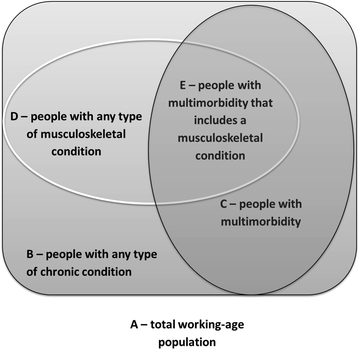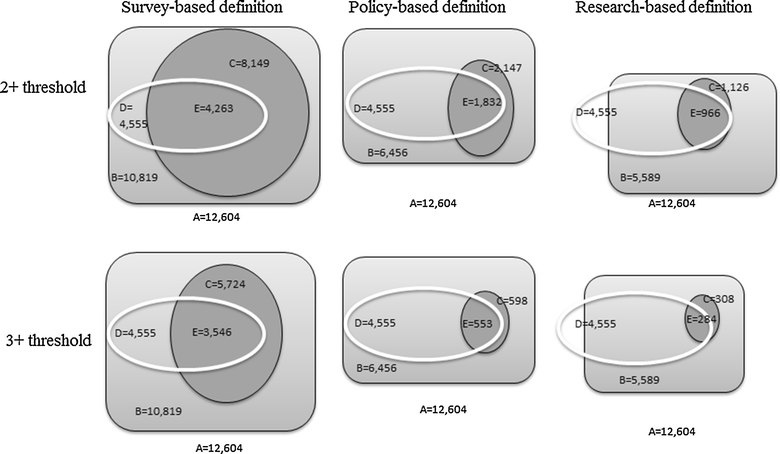Cross-sectional examination of musculoskeletal conditions and multimorbidity: influence of different thresholds and definitions on prevalence and association estimates
- PMID: 28100264
- PMCID: PMC5242059
- DOI: 10.1186/s13104-017-2376-4
Cross-sectional examination of musculoskeletal conditions and multimorbidity: influence of different thresholds and definitions on prevalence and association estimates
Abstract
Background: Multimorbidity and musculoskeletal conditions create substantial burden for people and health systems. Quantifying the extent of co-occurring conditions is hampered by conceptual heterogeneity, imprecision and/or indecision about how multimorbidity is defined. The purpose of this study is to examine the influence of different ways of operationalising multimorbidity on multimorbidity prevalence rates with a focus on working-age adults with musculoskeletal conditions. Weighted population prevalence rates of multimorbidity among working-age Australians were estimated using data from the National Health Survey. Two nominal thresholds (2+ or 3+ co-occurring conditions) and three operational definitions of multimorbidity (survey-, policy- and research-based) were examined. Using logistic regression, we estimated the association between the prevalence of multimorbidity among persons with musculoskeletal conditions compared to persons with non-musculoskeletal conditions for each definition and threshold combination.
Results: As few as 7.9% of working-age Australians have 2+ conditions using the research-based definition (95% CI 7.4-8.5%), compared to estimates of 15.3% (95% CI 14.3-16.2%) and 61.5% (95% CI 60.3-62.7%). with the policy- and survey-based definitions, respectively. Depending on definition, with the 3+ threshold multimorbidity prevalence ranged from 2.1% (research) to 41.9% (survey). Among the sub-sample with musculoskeletal conditions, multimorbidity with the 2+ threshold ranged from 20.2 to 92.2%; and with 3+ threshold from 5.9 to 75.4%, again lowest with the research-definition and highest with the survey-definition. When compared to any other condition (i.e. non-musculoskeletal conditions), all musculoskeletal conditions were positively associated with multimorbidity, regardless of definition or threshold.
Conclusions: Depending on definition and threshold, multimorbidity is either rare or endemic in working-age Australians. Irrespective of definition, musculoskeletal conditions are a near-ubiquitous feature of multimorbidity.
Keywords: Comorbidity; Multimorbidity; Musculoskeletal conditions; Prevalence.
Figures


References
-
- Arthritis and Osteoporosis Victoria . A problem worth solving. Elsternwick: Arthritis and Osteoporosis Victoria; 2013.
-
- Murray CJ, Vos T, Lozano R, Naghavi M, Flaxman AD, Michaud C, Ezzati M, Shibuya K, Salomon JA, Abdalla S, et al. Disability-adjusted life years (DALYs) for 291 diseases and injuries in 21 regions, 1990–2010: a systematic analysis for the Global Burden of Disease Study 2010. Lancet. 2012;380:2197–2223. doi: 10.1016/S0140-6736(12)61689-4. - DOI - PubMed
-
- Vos T, Flaxman AD, Naghavi M, Lozano R, Michaud C, Ezzati M, Shibuya K, Salomon JA, Abdalla S, Aboyans V, et al. Years lived with disability (YLDs) for 1160 sequelae of 289 diseases and injuries 1990–2010: a systematic analysis for the Global Burden of Disease Study 2010. Lancet. 2012;380:2163–2196. doi: 10.1016/S0140-6736(12)61729-2. - DOI - PMC - PubMed
MeSH terms
LinkOut - more resources
Full Text Sources
Other Literature Sources
Research Materials

